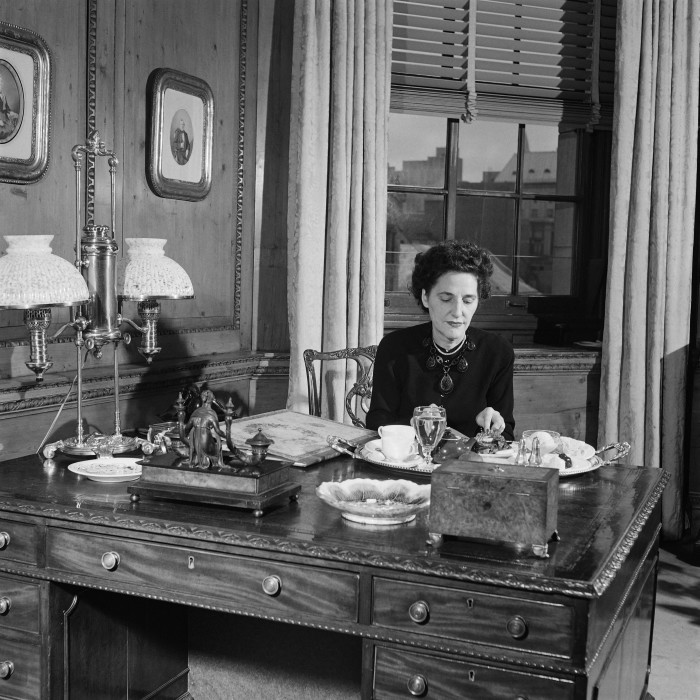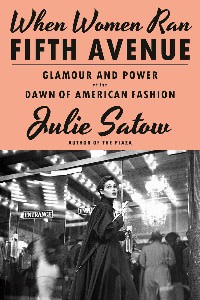
Unlock the Editor’s Digest for free
Roula Khalaf, Editor of the FT, selects her favourite stories in this weekly newsletter.
If ever there was a place where the impetus behind American consumerism and wealth in the 20th century could be located, it would be Fifth Avenue. Its glittering image as New York’s most lavish thoroughfare is often characterised by female shoppers surrounded by towering edifices named after retail giants.
Yet in our era of shopping malls and online conglomerates, the department store has largely ceased to exist. Today, the likes of Saks and Bergdorf Goodman — which still occupy prime real estate on Fifth Avenue — are among the last reminders of an era when one street in Manhattan was a symbol for the boundless possibilities of a retail culture seemingly attuned to every wish.
To tell the history of the storied avenue, you might assume that the male business tycoons behind these brands would take centre stage. In When Women Ran Fifth Avenue, Julie Satow begs to differ.
The author and journalist knows the territory. In her 2019 book The Plaza, she told the story of Fifth Avenue’s most famous luxury hotel, the “Serene Highness of 59th Street” as Tina Brown once dubbed it.
In this latest book, Satow presents a subversive history of a retail culture that was emblematic of the nation’s vast wealth, making a convincing case that the department store offered a rare environment where women could pursue mobile careers as business tycoons and tastemakers. “Department stores once provided invaluable opportunities for ambitious women,” writes Satow.
She makes her argument largely through the stories of three women, Hortense Odlum, Dorothy Shaver and Geraldine Stutz, who occupied some of the top jobs in Fifth Avenue’s leading department stores. These women weren’t necessarily born into the world of retail. Odlum rose to prominence at Bonwit Teller by virtue of her industrialist husband’s wealth; Shaver worked her way up from the shop floor to the head office at Lord & Taylor, becoming the first woman in the US to head a multimillion dollar company; and Stutz pivoted from a career in fashion journalism to flourish as a retail mogul at Henri Bendel.

They each ran their respective retail empires in distinctive ways: Odlum was noted for her unassuming business acumen; Shaver was famous for her idiosyncratic vision to champion an upcoming generation of American designers; and Stutz made her name as a style icon who crafted a new dress code. At the height of their powers in mid-20th century, this trio collectively captivated the minds and purses of a Manhattan milieu and showcased a unique ability to respond to — and at times mould — a country’s tastes, desires and sensibilities. Where Fifth Avenue led, Main Street followed.

Success brought various benefits — from sales running into the hundreds of millions of dollars, as well as glamorous lifestyles that allowed them to rub shoulders with the likes of Lee Radziwill and Princess Grace of Monaco. But over time, business failed to keep up with the rapidly changing whims of the retail market and, as these namesake stores became less profitable, the air of glamour surrounding them evaporated.
The book succeeds as a riveting saga interweaving tales of corporate power struggles and marital affairs. It is evidently deeply researched, drawing on personal testimonies, interviews with family members and field trips to the hometowns of her main subjects. There are also sporadic glimpses of lesser-known successful women retailers outside New York, such as Maggie Lena Walker, an African-American entrepreneur who founded St Luke’s Emporium in Richmond, Virginia.
The end result is a nuanced exploration of the politics of gender in an industry where women — often the objects of inspiration — were overshadowed by the men who owned the stores they worked in. Beneath the scandals and wealth, the running theme that guides Satow’s concluding thoughts is the plight of women who run businesses.
While they overcame the cultural prejudices that constrained their place in the fashion world and society at large, the most interesting moments arise when our characters begin to doubt the inherent virtue or value of their commercial success. “I was forced to take the job. I worked like a Trojan,” Odlum said in a newspaper interview after her retirement in 1940. “The whole thing leaves me cold.”
When Women Ran Fifth Avenue: Glamour and Power at the Dawn of American Fashion by Julie Satow, Doubleday $32.50, 320 pages
Join our online book group on Facebook at FT Books Café and subscribe to our podcast Life & Art wherever you listen